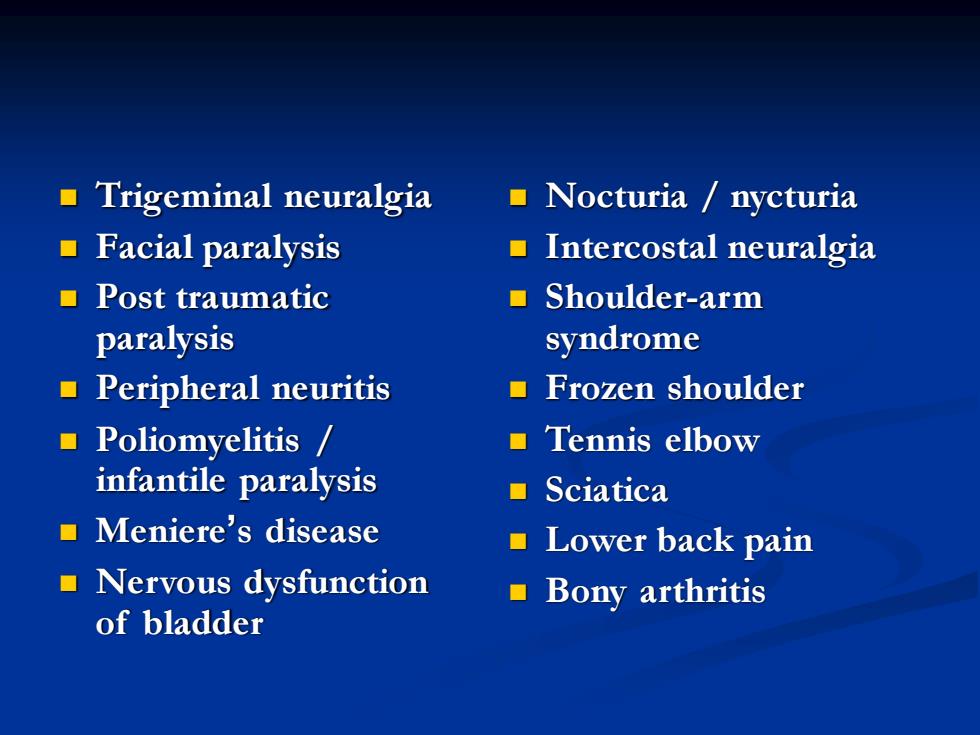
General introduction of acupuncture therapy
General introduction of acupuncture therapy

Indications of acupuncture nerve system:nervous headache,trificial neuraglgia,facial paralysis,facial spasm,apoplexy and its sequelae,paralysis due to arachnoid adnosion,sciatica,periathritis of shoulder, paralysis due to hysteria and epilepsy coronary heart disease,anginal pectoris,acute myocardiac infarction,arrhythmia,hypertension, thrombotic angiitis and Taynand's disease
Indications of acupuncture ◼ nerve system: nervous headache, trificial neuraglgia, facial paralysis, facial spasm, apoplexy and its sequelae, paralysis due to arachnoid adnosion, sciatica, periathritis of shoulder, paralysis due to hysteria and epilepsy ◼ coronary heart disease, anginal pectoris, acute myocardiac infarction, arrhythmia, hypertension, thrombotic angiitis and Taynand’s disease

acute and chronic ulcerative colitis,bacillary dysentery,chronic cholecystitis,hepatolith,gastric ulcer and gastraptosia ■bronchial asthma irregulation of menstruation,dysmenorrhea, infertility /sterility acute tonsillitis,acute sore throat,stomatitis,acute rhititis,myopia in children and young acupuncture anesthesia:thyroidectomy,cesarean section,repair of hernia,vasoligation and subtital gastrectomy
◼ acute and chronic ulcerative colitis, bacillary dysentery, chronic cholecystitis, hepatolith, gastric ulcer and gastraptosia ◼ bronchial asthma ◼ irregulation of menstruation, dysmenorrhea, infertility / sterility ◼ acute tonsillitis, acute sore throat, stomatitis, acute rhititis, myopia in children and young ◼ acupuncture anesthesia: thyroidectomy, cesarean section, repair of hernia, vasoligation and subtital gastrectomy

Indications of moxibustion ■arthralgia chronic diarrhea,chronic dysentery,phlegm retention and flaccidity syndrome common cold,parotitis malposition of the fetus,leukorrhea and prolapse of uterus infantile enuresis and chronic diarrhea
Indications of moxibustion ◼ arthralgia ◼ chronic diarrhea, chronic dysentery, phlegm retention and flaccidity syndrome ◼ common cold, parotitis ◼ malposition of the fetus, leukorrhea and prolapse of uterus ◼ infantile enuresis and chronic diarrhea

Diseases WHO recommended ■Acute and chronic Central serous rhinitis choroido retunitis ■Acute and chronic ■yopia nasosinusitis ■Cataract ■Common cold ■Toothache ■Acute and chronic Post tooth extraction tonsillitis pain ■Acute and chronic Gingivitis trachitis Acute and chronic ■Bronchial asthma laryngitis Acute conjunctivitis
Diseases WHO recommended ◼ Acute and chronic rhinitis ◼ Acute and chronic nasosinusitis ◼ Common cold ◼ Acute and chronic tonsillitis ◼ Acute and chronic trachitis ◼ Bronchial asthma ◼ Acute conjunctivitis ◼ Central serous choroido retunitis ◼ Myopia ◼ Cataract ◼ Toothache ◼ Post tooth extraction pain ◼ Gingivitis ◼ Acute and chronic laryngitis

Esophageal achalasia ■Acute and chronic cardiospasm colitis ■Hiccup ■Acute and chronic ■Gastroptosia bacillary dysentery ■Acute and chronic ■ Constipation gastritis ■Diarrhea ·Hyperchlorhydria Paralytic intestinal ■Acute and chronic colic duodenal ulcer ■Headache ■ Migraine
◼ Esophageal achalasia / cardiospasm ◼ Hiccup ◼ Gastroptosia ◼ Acute and chronic gastritis ◼ Hyperchlorhydria ◼ Acute and chronic duodenal ulcer ◼ Acute and chronic colitis ◼ Acute and chronic bacillary dysentery ◼ Constipation ◼ Diarrhea ◼ Paralytic intestinal colic ◼ Headache ◼ Migraine

Trigeminal neuralgia ■Nocturia/nycturia ■Facial paralysis Intercostal neuralgia ■Post traumatic Shoulder-arm paralysis syndrome Peripheral neuritis ■Frozen shoulder ■Poliomyelitis/ ■Tennis elbow infantile paralysis ■Sciatica ■Meniere's disease ■Lower back pain ■Nervous dysfunction ■Bony arthritis of bladder
◼ Trigeminal neuralgia ◼ Facial paralysis ◼ Post traumatic paralysis ◼ Peripheral neuritis ◼ Poliomyelitis / infantile paralysis ◼ Meniere’s disease ◼ Nervous dysfunction of bladder ◼ Nocturia / nycturia ◼ Intercostal neuralgia ◼ Shoulder-arm syndrome ◼ Frozen shoulder ◼ Tennis elbow ◼ Sciatica ◼ Lower back pain ◼ Bony arthritis

Principles of selecting Points according to the properties of points according to differentiation
Principles of selecting Points ◼ according to the properties of points ◼ according to differentiation

■Properties of points How to chose points Local functions local points Remote functions distal points Special functions symptomatic points
◼ Properties of points How to chose points Local functions local points Remote functions distal points Special functions symptomatic points

Headache: (local)DU20,EX-HN5,GB20,EX-HN1 (distal)SJ5,LI4,LR3,BL60 ■knee: (local)GB34,ST36,BL40 ■ankle: ■(ocal)BL60,KI3
◼ Headache: ◼ (local) DU20, EX-HN5, GB20, EX-HN1 ◼ (distal) SJ5, LI4, LR3, BL60 ◼ knee: ◼ (local) GB34, ST36, BL40 ◼ ankle: ◼ (local) BL60, KI3